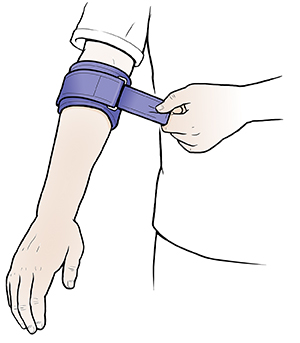A
B
C
D
E
F
G
H
I
J
K
L
M
N
O
P
Q
R
S
T
U
V
W
X
Y
Z
Click a letter to see a list of medical procedures beginning with that letter.
Click 'Back to Intro' to return to the beginning of this section.
Treating Tennis Elbow
Your treatment will depend on how inflamed your tendon is. The goal is to ease your symptoms and help you regain full use of your elbow.
Rest and medicine

Wear a tennis elbow splint to let the inflamed tendon rest and heal. It must be worn correctly. It should be placed down the arm past the painful area of the elbow. It can make symptoms worse if it's directly over the inflamed tendon. Take stress off the tendon by using your other hand or changing your grip. Take NSAIDs (nonsteroidal anti-inflammatory drugs) for pain and inflammation. Talk with your healthcare provider before taking these if you have chronic liver or kidney disease or had a stomach ulcer or digestive bleeding. Also talk with your provider if you take a blood thinner.
It may be helpful to use ice pack for the first 24 to 48 hours after the pain first starts. Ice will help ease pain and swelling. Use the ice pack for 10 to 20 minutes at a time. Don't put ice directly on your skin. To protect your skin and prevent skin damage, wrap the ice pack in a thin cloth or towel.
Exercises and therapy
Your healthcare provider may give you an exercise program. They may send you to a physical therapist. That expert will teach you how to gently stretch and strengthen the muscles around your elbow.
Anti-inflammatory shots
Your healthcare provider may give you shots of an anti-inflammatory medicine, such as cortisone. This helps ease swelling. You may have more pain at first. But your elbow should feel better in a few days.
Another option is a shot called PRP or platelet rich plasma. This is a specialized injection that uses a sample of your own blood to inject growth factors into the damaged tendon to try to allow it to heal.
If surgery is needed
If your symptoms go on for a long time, or other treatments don’t work, your healthcare provider may recommend surgery. Surgery releases the inflamed tendon taking the tension off the tendon.
Online Medical Reviewer:
Mike Murphy
Online Medical Reviewer:
Raymond Kent Turley BSN MSN RN
Online Medical Reviewer:
Terri Koson DNP RN ACNP
Date Last Reviewed:
9/1/2025
© 2000-2025 The StayWell Company, LLC. All rights reserved. This information is not intended as a substitute for professional medical care. Always follow your healthcare professional's instructions.